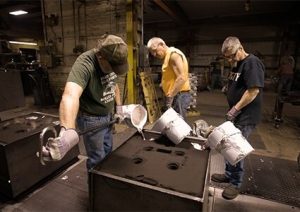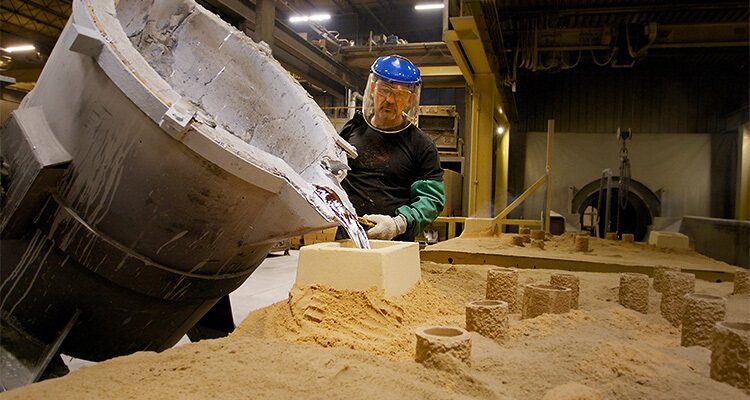How Metal Castings Improve Structural Integrity and Performance
Wiki Article
Discovering the Ingenious Methods Utilized in Modern Aluminum Foundries
Modern aluminum foundries are going through a considerable makeover through the adoption of innovative strategies. Advanced casting approaches, smart automation, and lasting methods are reshaping production procedures. These innovations not just boost effectiveness but likewise address environmental concerns. As the industry progresses, the combination of electronic innovations plays an essential function. Understanding these changes is crucial for understanding the future of aluminum manufacturing and its ramifications for global markets. What lies ahead in this vibrant industry?Advanced Casting Techniques

Furthermore, developments in thermal control and mold layout have actually added to more regular casting outcomes. These innovations enable for far better control of cooling prices, decreasing problems and boosting mechanical residential properties. Consequently, manufacturers can develop lightweight yet durable parts, satisfying the increasing needs of various sectors, including auto and aerospace, for high-performance aluminum components.
Smart Automation and Robotics
The integration of wise automation and robotics in aluminum foundries marks a significant development in producing efficiency. These modern technologies enable accuracy and uniformity in production procedures, drastically minimizing human mistake and enhancing safety. Automated robot systems take care of repetitive jobs, such as molding, putting, and cooling, enabling human drivers to focus on more complex duties that need critical thinking and oversight.Furthermore, clever sensing units and AI-driven analytics offer real-time information monitoring, promoting predictive upkeep and reducing downtime. This causes maximized resource allocation and improved power consumption, adding to total sustainability in manufacturing.
In addition, the versatility of robotic systems allows for quick modifications to transforming production needs, boosting flexibility in production. As foundries significantly adopt these sophisticated innovations, they not only boost functional efficiency yet additionally position themselves as leaders in innovation within the metal casting industry.
Additive Production in Foundries
Changing typical manufacturing methods, additive manufacturing is revolutionizing aluminum foundries by allowing the production of complex geometries that were formerly unattainable. This strategy enables for the layer-by-layer construction of parts, substantially decreasing material waste and shortening production times. As a result, foundries can generate detailed styles that boost performance and performance, providing to the growing demands of numerous markets.Moreover, additive production assists in quick prototyping, enabling engineers to test and repeat styles swiftly. This dexterity not just accelerates the advancement cycle yet additionally assists in recognizing prospective problems before full-scale manufacturing starts. The assimilation of advanced materials and processes in additive production better boosts the mechanical residential or commercial properties of aluminum parts, promoting technology in product design. As a result, aluminum foundries that adopt these methods position themselves at the center of sector developments, making certain competition in an ever-evolving market landscape.
Lasting Practices and Recycling
Lasting methods in aluminum foundries are increasingly concentrated on boosting recycling procedures and taking on environment-friendly casting strategies. These technologies aim to lower waste and power intake while making the most of the use of recycled materials. As the sector develops, the combination of sustainability into manufacturing approaches becomes crucial for satisfying ecological standards and consumer needs.Recycling Process Improvements
As sectors increasingly recognize the environmental effect of waste, aluminum foundries are adopting innovative reusing process renovations to improve sustainability. These advancements concentrate on minimizing energy usage and optimizing material healing. For circumstances, several foundries are carrying out closed-loop systems that recycle scrap aluminum produced during manufacturing, decreasing waste and minimizing the requirement for virgin products. Advanced arranging modern technologies, such as automatic optical sorting, enhance the splitting up of different aluminum grades, raising the effectiveness of the recycling procedure. Additionally, some foundries are utilizing hydrometallurgical approaches to recover aluminum from intricate waste streams. By incorporating these enhancements, aluminum foundries not only add to a round economic situation but additionally reduce their carbon footprint, lining up with global sustainability goals.Eco-Friendly Casting Techniques
While standard casting techniques often involve substantial energy consumption and material waste, aluminum foundries are significantly adopting environmentally friendly casting methods that focus on sustainability. Strategies such as low-pressure die casting, which decreases air exhausts, and the use of water-based mold releases add to minimized ecological effect. Furthermore, advancements in 3D printing modern technology permit for the development of complicated mold and mildews with much less material waste. Numerous foundries are likewise carrying out closed-loop systems that reuse water and aluminum scrap, further lowering source usage. By accepting renewable energy sources, such as solar and wind power, these centers boost their sustainability initiatives. In general, the adoption of green practices in aluminum casting not just profits the atmosphere yet additionally promotes financial Look At This efficiency and technology within the sector.Improved Top Quality Control Measures
Boosted quality assurance measures in aluminum foundries are significantly dependent on sophisticated inspection innovations and real-time monitoring systems. These technologies make it possible for suppliers to identify problems early and assure regular item quality. By incorporating these devices, foundries can considerably improve their operational effectiveness and minimize waste.Advanced Inspection Technologies
Advanced examination innovations play an important function in making certain the high quality and integrity of aluminum castings. These sophisticated techniques include non-destructive screening (NDT) strategies such as ultrasonic screening, radiographic testing, and eddy current inspections. Each method enables detailed assessment of spreadings without endangering their architectural stability. Advanced imaging methods, such as computed tomography, provide an extensive sight of internal attributes, enabling the detection of problems like voids and additions. In addition, automated optical evaluation systems enhance accuracy by using high-resolution cameras and artificial intelligence formulas to assess surface area quality. By carrying out these advanced examination innovations, aluminum foundries can efficiently decrease issues, guaranteeing that spreadings meet rigorous sector criteria and client needs.Real-Time Tracking Systems
As manufacturers endeavor for excellence in aluminum casting, real-time surveillance systems emerge as an essential enhancement in quality assurance procedures. These systems make use of advanced sensing units and information analytics to continually track important parameters throughout the casting procedure, such as alloy, pressure, and temperature level composition. By supplying immediate comments, they enable operators to identify discrepancies from suitable conditions and make punctual adjustments. This positive method not just lessens issues but additionally enhances overall he said efficiency and lowers waste - Metal Castings. Furthermore, assimilation of real-time information into production management systems promotes far better decision-making and improves traceability. Consequently, real-time surveillance systems play a crucial role in keeping high criteria of high quality in modern-day aluminum foundries, making certain that items fulfill strict sector specificationsDigital Double Innovation for Optimization

The integration of digital twin technology permits foundries to evaluate different situations without interfering with real manufacturing. This capability promotes a positive method to upkeep and source administration, inevitably lowering waste and decreasing functional expenses. In addition, the technology aids in process optimization by allowing designers to visualize the effects of adjustments in real-time, guaranteeing better outcomes. As an outcome, aluminum foundries embracing digital twin innovation are placed to accomplish higher efficiency and competitiveness in a significantly requiring market.

Sector 4.0 and IoT Integration
The fostering of digital twin modern technology in aluminum foundries becomes part of a broader activity towards Industry 4.0, characterized by the assimilation of the Web of Points (IoT) right into making procedures. This integration makes it possible for real-time tracking and data collection from numerous machinery and devices, resulting in boosted functional effectiveness. Sensors embedded in machines gather why not check here essential data, which is evaluated to maximize production process and anticipate upkeep requirements.Furthermore, IoT devices facilitate communication in between different manufacturing stages, permitting smooth control and reducing downtime. By leveraging cloud computing, foundries can save and examine substantial amounts of information, enabling even more enlightened decision-making. This innovation additionally sustains remote monitoring, where operators can oversee processes from anywhere, improving responsiveness to manufacturing obstacles. Overall, the fusion of Industry 4.0 and IoT within aluminum foundries is changing traditional practices, making them extra dexterous and receptive to market needs.
Regularly Asked Concerns
What Are the Key Advantages of Aluminum Over Various Other Steels?
Aluminum offers many advantages over other metals, including its lightweight nature, excellent deterioration resistance, high thermal and electric conductivity, pliability, and recyclability, making it a favored selection for various applications throughout numerous industries. - Aluminum FoundryJust How Do Modern Foundries Deal With Hazardous Materials?
Modern foundries take care of hazardous products with rigorous safety and security methods, progressed filtering systems, and reusing methods. Normal training assurances employees understand finest methods, while monitoring systems find and minimize possible risks to maintain a secure functioning environment.What Is the Common Life-span of Aluminum Castings?
The normal lifespan of aluminum spreadings ranges from 20 to 50 years, depending on aspects such as ecological problems, usage, and upkeep. Appropriate care can prolong their durability and efficiency significantly with time.Are There Any Health And Wellness Risks Connected With Aluminum Foundry Work?
Yes, aluminum foundry work poses health threats, including respiratory system problems from inhaling fumes and dust, skin irritation from call with liquified steel, and prospective direct exposure to hazardous chemicals. Appropriate precaution are vital to alleviate these dangers.Exactly How Do Shops Make Certain Worker Security in High-Temperature Environments?
Foundries execute strenuous security protocols, including safety equipment, temperature tracking systems, and regular training. These actions assure that employees are equipped to handle high-temperature atmospheres, lessening risks and advertising a more secure work environment.
Numerous advanced casting strategies have actually arised in aluminum foundries, revolutionizing traditional processes. Sustainable practices in aluminum foundries are significantly concentrated on boosting recycling procedures and embracing environmentally friendly casting techniques. Numerous foundries are carrying out closed-loop systems that reuse scrap aluminum generated throughout production, reducing waste and reducing the requirement for virgin products. While standard casting methods often entail substantial energy intake and product waste, aluminum foundries are significantly adopting environmentally friendly casting strategies that prioritize sustainability. While many markets are increasingly taking on digital modern technologies, aluminum foundries are leveraging electronic twin modern technology to enhance functional efficiency and optimize production procedures.
Report this wiki page